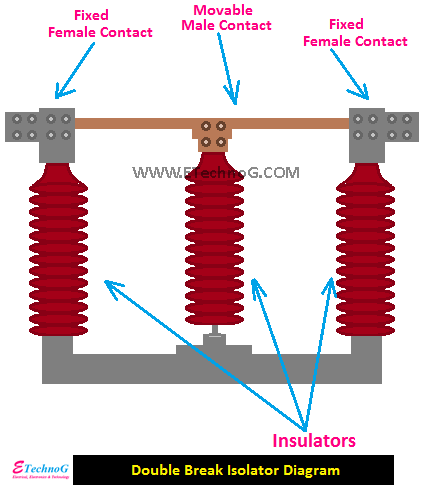Definition
•Isolator is a mechanical switch that isolates a part of the circuit from the system when required. Isolators are used to open a circuit under NO LOAD conditions.
•Isolators are generally used on both ends of the breaker for safe repair or replacement of the circuit breaker. The construction and operating mechanism vary based on the voltage level at which isolating switch needs to be operated.
There is a need for proper installation, alignment, and maintenance of disconnecting switches of ratings for smooth functioning.
Types of Isolator
According to system requirements:
A. Horizontal Break
a. Double Break Isolator
b. Single Break Isolator (center break)
B. Vertical Break
C. Pantograph type Isolator.
According to the layout:
A. Single Isolator (SI)
B. Double Isolator (DI)
C. Beam-mounted
D. Off Set (Tandem) Isolator
E. Isolator with E/S, Double E/S, without E/S
These are some of the common types of isolators used in substations. The selection of isolators depends on various factors, including voltage level, fault current interruption requirements, space limitations, and operational needs, among others. It’s important to consult with qualified engineers and follow relevant standards and regulations when designing, installing, and operating isolators in a substation.

Parts of Isolator
- Moving Contact
- Moving Contact Arcing Horn
- Copper Jaw
- Lever Arm
- Clamp
- Male Contact
- Jumper Pad
- Insulator Stack
- Elevator Plate
- Base Channel
- Isolator Blades: The isolator blades are the main components of the isolator that open or close the electrical circuit. The isolator blades are mounted on a rotating shaft and can be operated manually or by a motor.
- Drive Mechanism: The drive mechanism is responsible for operating the isolator blades. It typically consists of a motor, gear system, and coupling arrangement. The motor provides the driving force, while the gear system converts the motor’s rotational motion to linear motion, which is used to open or close the isolator blades. The coupling arrangement connects the motor and gear system to the isolator blades and ensures proper synchronization of their movements.
- Control Panel: The control panel houses the electrical components and control devices that are used to operate the motorized isolator. It typically includes motor starters, control switches, protective relays, and other electrical components. The control panel is used to start, stop, and control the motor that operates the isolator blades, and it may also include monitoring and signaling devices to indicate the status of the isolator.
- Operating Mechanism: The operating mechanism is used to manually operate the motorized isolator in case of motor failure or emergency situations. It typically includes a manual crank or handle that can be used to manually rotate the isolator blades and open or close the circuit. The operating mechanism provides a backup method for operating the isolator when the motorized operation is not available.
- Mounting Structure: The mounting structure provides mechanical support and stability for the motorized isolator. It typically includes a sturdy framework, base plates, and other structural components that are designed to withstand the mechanical stresses and environmental conditions in a substation. The mounting structure is designed to ensure proper alignment and positioning of the isolator blades for reliable operation.
- Earth Switch: The earth switch is a part of the motorized isolator that is used for earthing or grounding of the electrical circuit. It typically consists of a separate blade or contact that is connected to the ground or earth. The earth switch can be operated manually or by motor, and it is used to provide a direct path for current to flow to the ground, ensuring that the electrical circuit is safely grounded during maintenance or repairs.
- Interlocking Devices: Interlocking devices are safety features that are designed to prevent unsafe operations or conditions. They are typically integrated into the motorized isolator to ensure proper sequencing of operations and prevent incorrect or unsafe operations. Interlocking devices may include mechanical, electrical, or electronic devices that prevent the motorized isolator from being operated in an unsafe or incorrect manner.
Summary
It’s important to note that the specific design and features of motorized isolators may vary depending on the manufacturer, model, and application requirements. It’s crucial to follow the manufacturer’s instructions, relevant standards, and regulations, and consult with qualified engineers during the design, installation, and operation of motorized isolators in a substation to ensure safe and reliable operation.

